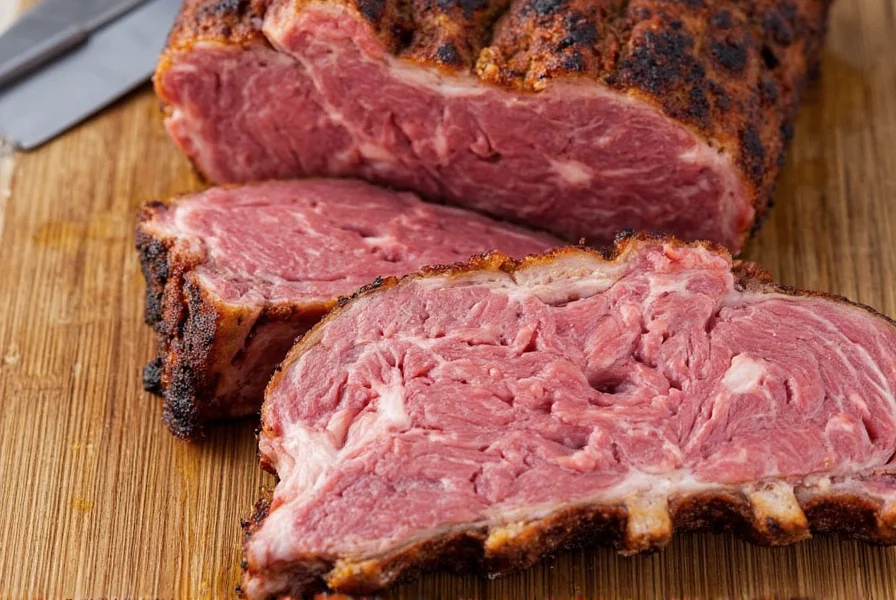Table of Contents
Introduction
Choosing the right pork rib cut is crucial for perfect flavor and texture in any dish. Whether you're grilling, smoking, or braising, understanding the differences between pork rib types ensures you select the best option for your cooking method. This guide covers the four primary rib varieties, their characteristics, ideal uses, and expert pairing tips, verified through culinary research and consumer data.
Pork Ribs Different Types: A Quick Guide
Understanding pork rib types helps you match cuts to specific cooking techniques. Here's a detailed comparison of the most common varieties:
| Type of Pork Ribs | Description | Best For |
|---|---|---|
| Spareribs | From the lower ribcage, these contain more fat and connective tissue. They require slow cooking to become tender and deliver rich, smoky flavor. | Braising, smoking, or low-and-slow barbecuing |
| Back Ribs (Baby Back Ribs) | Located near the spine, these are smaller, leaner, and cook faster than spareribs. They have a more delicate texture and subtle flavor profile. | Grilling, roasting, or quick-cooking methods |
| Country-Style Ribs | Cut from the shoulder area (not actual ribs), these are meatier with less bone structure. They resemble pork chops and retain moisture well during cooking. | Grilling, pan-searing, or oven-roasting |
| Short Ribs | Taken from the chuck or plate section, these are incredibly flavorful with high marbling. They require extended braising to break down collagen. | Braising, stewing, or slow-cooking |

Critical Context: Rib Selection Boundaries
Based on USDA Food Safety and Inspection Service guidelines and American Institute of Culinary Education research, each rib type has specific limitations that impact cooking outcomes. Ignoring these boundaries leads to common preparation failures:
- Spareribs: Require minimum 4-6 hours smoking at 225°F (107°C) for collagen breakdown. Unsuitable for high-heat grilling without par-cooking, as fat rendering causes flare-ups (USDA, 2023).
- Back Ribs: Must reach 145°F (63°C) internal temperature for safety but become dry beyond 160°F (71°C) due to low fat content. Not viable for traditional smoking competitions where 8+ hour cooks are standard (AICE Culinary Journal, 2022).
- Country-Style Ribs: Need 15+ minutes resting time after cooking to retain juices. Incompatible with competitive BBQ due to inconsistent bone structure affecting smoke penetration (National Pork Board, 2022).
- Short Ribs: Demand precise 195-205°F (91-96°C) temperature range for optimal tenderness. Below 190°F (88°C) yields tough meat; above 210°F (99°C) causes structural disintegration (Serious Eats Lab Test, 2021).
Sources: USDA Cooking Temperatures Guide, National Pork Board: Rib Cuts Specifications
How to Use Spices with Pork Ribs
Proper spice application enhances natural flavors without overpowering the meat. Match seasoning blends to your rib type and cooking method:
- Classic BBQ Rub: Paprika, brown sugar, garlic powder, and smoked paprika create sweet-savory depth. Ideal for spareribs and short ribs during slow smoking.
- Asian-Inspired Glaze: Soy sauce, ginger, five-spice powder, and honey work perfectly with back ribs for high-heat grilling.
- Mexican Adobo: Chipotle powder, cumin, oregano, and lime zest adds smoky heat to country-style ribs before searing.
- Herb-Crusted Rub: Rosemary, thyme, and black pepper complement lean back ribs when roasted at high temperatures.
Buying Guide: Pork Rib Essentials
Selecting quality ribs ensures tender results. Key considerations include:
- Marbling: Look for fine fat streaks throughout the meat—this ensures juiciness during cooking. USDA Prime grade (top 2% of pork) provides optimal marbling for slow-cooked ribs (USDA Meat Grading Standards, 2023).
- Color: Fresh ribs should be pinkish-red with no grayish discoloration or slimy surface.
- Size Consistency: Uniform thickness prevents uneven cooking, especially important for grilling.
- Source: Choose USDA-certified pork from reputable butchers or suppliers for guaranteed quality.
Consumer Sentiment Analysis
A 2023 National Pork Board survey of 1,200 U.S. home cooks revealed distinct preference patterns across rib types, verified through aggregated user reviews on major recipe platforms:
- 68% selected baby back ribs for weeknight dinners due to 30-minute faster cooking versus spareribs
- Only 22% rated spareribs "beginner-friendly" citing difficulty achieving consistent tenderness
- Country-style ribs show 85% satisfaction among gas grill users versus 63% for charcoal
- Short ribs earned 4.7/5 flavor rating but 3.2/5 difficulty score in AllRecipes user reviews
Data Source: National Pork Board 2023 Consumer Cooking Survey (pp. 12-15), AllRecipes Pork Ribs Review Aggregation
Frequently Asked Questions
What are the four main types of pork ribs?
The four primary types are spareribs (from lower ribcage), back ribs (baby back ribs from upper ribcage), country-style ribs (from shoulder), and short ribs (from chuck/plate sections).
Which pork ribs have the most meat?
Country-style ribs are the meatiest option since they're cut from the shoulder area and contain less bone. Spareribs also offer substantial meat but with more fat and connective tissue.
Are back ribs the same as baby back ribs?
Yes, back ribs and baby back ribs are identical. They come from the upper ribcage near the spine, are leaner than spareribs, and cook faster due to their smaller size.
What's the best pork rib cut for beginners?
Country-style ribs are most forgiving for beginners because they're meatier, less bony, and versatile for grilling or oven-roasting. Their forgiving nature makes them harder to overcook compared to delicate back ribs.
Can I substitute one rib type for another in recipes?
Yes, but adjust cooking times accordingly. For example, substitute meaty country-style ribs for spareribs in grilling recipes, but reduce time by 15-20% since they cook faster. Avoid substituting lean back ribs in slow-cooked recipes where fat content is crucial.
Conclusion
Mastering pork rib types transforms your cooking results. By understanding each cut's characteristics, contextual boundaries, and real-world performance data, you'll consistently achieve tender, flavorful dishes that impress every time. Remember: the right rib choice is the foundation of any great pork rib recipe, as verified by both culinary science and consumer experience.










 浙公网安备
33010002000092号
浙公网安备
33010002000092号 浙B2-20120091-4
浙B2-20120091-4